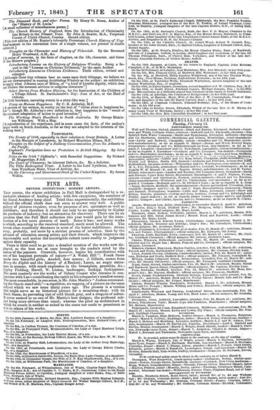FINE ARTS.
BRITISH INSTITUTION : MODERN ARTISTS.
Tuts season, the winter exhibition in Pall Mall is distinguished by a re- markable absence of leading artists: with few exceptions, the members of the Royal Academy keep aloof. Tried thus experimentally, the exhibition without the official chiefs does not seem to answer very well. A public gallery of pictures requires, even for purposes of art, spectators as well as exhibitors; and therefore it should not only be an opportunity to display the products of industry, but an attraction for observers. There can be no question that the Pall Mall collection this year would gain by the intro- duction of a few more pictures of' mark. Some it has; and many works to which, according to the received standard, merit must be allowed. The lowest class manifestly decreases in most of the better exhibitions; driven away, probably, not more by a stricter process of selection, than by the advance of education among artists and their friends, which improves the improveable and makes thd incorrigible submit more readily to judgment against their capacity. There is little need to go into a detailed mention of the works now dis- played, as the best are at once brought to the reader's mind by the names of the painters. Creswick, however, begins his contributions with one of his happiest portraits of nature-" A Welsh Hill "; Frank Stone sends two beautiful girls; Anadell, deer scenes; J. Gilbert, scenes from Henry the Eighth and the history of A'Beckett; Lance, an angry states. man in armour, with much expression in the breastplate, gauntlets, &c.; Copley Fielding, Havel], W. Linton, landscapes; Inskipp, Inskippisms. The most masterly are the works of Sidney Cooper who remains in con- junction with Lee-contributing the cattle to his companion's meadow scenes. The most remarkable, in one sense, is Mr. John Martin's " Joshua command- ing the Sun to stand still,"-a repetition, we suppose, of a picture on the same subject which we saw some thirty years ago. The present is a version that might serve as an historical picture for a mourning-shop; with its black frame, its pervading tint of cold bluish grey, and a soupcon of colour. It never seemed to us one of Mr. Martin's best designs; the professed sub- ject being more obvious than usual; whereas the piled up architecture in which he excels is neither so suited to the scene nor made so prominent as it is in others of his works.






















 Previous page
Previous page